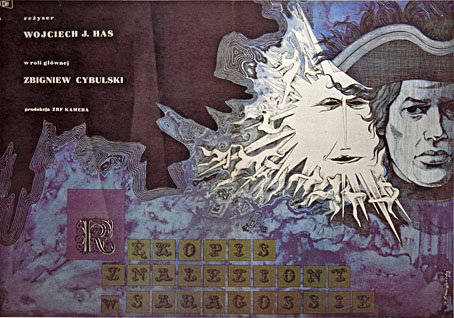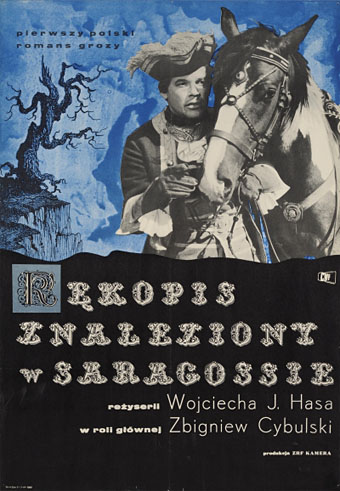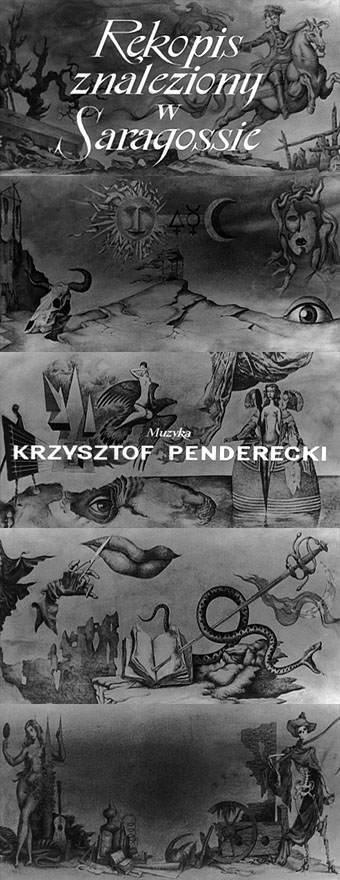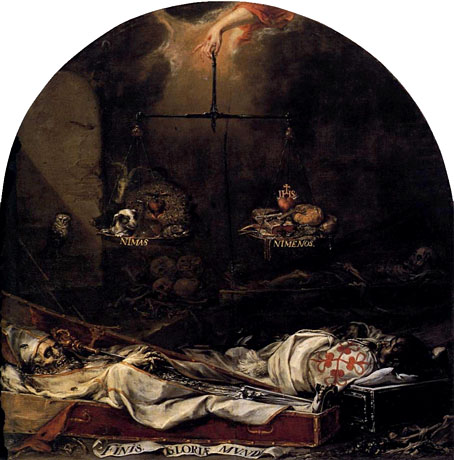Today’s post was convulsive in its beauty.
Previously on { feuilleton }
• Topsychopor by Roland Topor
A journal by artist and designer John Coulthart.
Today’s post was convulsive in its beauty.
Previously on { feuilleton }
• Topsychopor by Roland Topor

Polish poster (1965) by Jerzy Skarzynski who was also the film’s production designer.
I love The Saragossa Manuscript, both the novel by Potocki and the movie by Has. I saw the film three times which, in my case, is absolutely exceptional.
Luis Buñuel in My Last Sigh (1983)
No surprise that a lifelong Surrealist was enamoured with Jan Potocki’s rambling collection of stories-within-stories. The 1965 Polish film by Wojciech Has had another famous enthusiast in Jerry Garcia whose efforts to restore and reissue The Saragossa Manuscript helped bring the film to a new generation of viewers in 1999. I was a beneficiary of this, having been intrigued for years by descriptions whilst hoping in vain that it might turn up on television. I prefer the film to the novel although to be fair to Potocki it’s a long time since I read his book.

Another Polish design showing Zbigniew Cybulski as Alphonse.
Watching The Saragossa Manuscript again this weekend sent me looking for posters, some of which can be seen below. There are odd omissions: plenty of examples from the Eastern Bloc countries but few at all from Western Europe. The film suffered by having its 3-hour running time hacked about by distributors which didn’t help its reception outside Poland. The manuscript of the title is a book discovered during a skirmish in the Napoleonic wars, an account of the strange adventures of Alphonse Van Worden in the Sierra Morena region of Spain; one of the soldiers reading the manuscript is Van Worden’s grandson, the first of many coincidental connections. Van Worden’s adventures seem macabre at first—there are more bones in the opening scenes than in many horror films—but they soon turn farcical. As a burgeoning cast of characters appears, many of whom have their own tales to tell, the mood veers into outright sex comedy, albeit with mild philosophical overtones. Some scenes aren’t very far removed from Monty Python, especially those that feature an inept band of Spanish Inquisitors.

Background drawings from the title sequence. Yes, the score is by Penderecki, his first.
All of which means this is another film that presents a challenge for a poster designer. Most of the early examples take their cues from the opening titles whose backgrounds feature drawings with a vaguely Surrealist and occult flavour that I’m guessing are also the work of Jerzy Skarzynski.
In ictu oculi (1672).
Having castigated Somerset Maugham yesterday for a novel that even he professed to dislike, thanks can be offered for the passage in The Magician which draws attention to a painter I hadn’t come across before. With a scythe-wielding skeleton snuffing a candle flame, and a bishop rotting in his casket, these are a very Spanish take on the vanitas genre. Some of the subsequent works of Salvador Dalí and Luis Buñuel are less surprising when you see art that’s this grotesque.

Finis gloria mundi (1672).
Previously on { feuilleton }
• Alfred Rethel’s Totentanz
• The art of Jacopo Ligozzi, 1547–1627
• Massachusetts memento mori
• Skull cameras
• Walmor Corrêa’s Memento Mori
• The skull beneath the skin
• Vanitas paintings
• Very Hungry God
• History of the skull as symbol
What is there to say about Buñuel and Dalí’s timeless film that hasn’t already been said? It’s one of the primary Surrealist documents and something that everyone should see at least once. Cyril Connolly attended the Paris premiere in 1929:
The picture was received with shouts and boos and when a pale young man tried to make a speech, hats and sticks were flung at the screen. In one corner a woman was chanting, “Salopes, salopes, salopes!” and soon the audience began to join in. With the impression of having witnessed some infinitely ancient horror, Saturn swallowing his sons, we made our way out into the cold of February, 1929, that unique and dazzling cold…
Why does this strong impression still persist? Because Un Chien Andalou brought out the grandeur of the conflict inherent in romantic love, the truth that the heart is made to be broken, and after it has mended, to be broken again. For romantic love, the supreme intoxication of which we are capable, is more than an intensifying of life; it is a defiance of it and belongs to those evasions of reality through excessive stimulus which Spinoza called “titivations.” By the law of diminishing returns our desperate century forfeits the chance of being happy and, because it finds happiness insipid, our world is regressing to chaos.
The film comes and goes on YouTube so serious viewers are directed to the BFI DVD/Blu-ray release which comes twinned with Buñuel’s L’Age D’Or.
Previously on { feuilleton }
• Dreams That Money Can Buy
• La femme 100 têtes by Eric Duvivier
• Entr’acte by René Clair
Hardly a week passes without the religious right in America getting their knickers in a twist over some new iniquity, a condition so commonplace that new outbreaks are barely worth acknowledging. However, this week’s storm in a teacup caught my attention for being art-related.
If there’s one thing certain American Christians have in common with Muslim fundamentalists, it’s the habit of reacting to anything remotely gay with all the composure of caged baboons being prodded with sharp sticks. The pointed implement on this occasion has been the poster for the Folsom Street Fair, an annual Leather Pride/BDSM event held in San Francisco. The photograph by FredAlert (site NSFW) continues what’s become a minor tradition in artistic parody by working a variation on Leonardo da Vinci’s The Last Supper (1498), with leather girls and guys for the disciples and a black man in the place of Leonardo’s Jesus. The flag on the table is a Leather Pride flag. The intent behind the poster was explained by Andy Cooper, one of the event’s organisers:
There is no intention to be particularly pro-religion or anti-religion with this poster; the image is intended only to be reminiscent of the Last Supper painting. It is a distinctive representation of diversity with women and men, people of all colors and sexual orientations.
(…)
We hope that people will enjoy the artistry for what it is—nothing more or less. Many people choose to speculate on deeper meanings. This is one artist’s imagining of the Last Supper, and we have made it our own. The irony is that da Vinci was widely considered to be homosexual. In truth, we are going to produce a series of inspired poster images over the next few years. Next year’s poster ad may take inspiration from American Gothic by Grant Wood or Edvard Munch’s The Scream or even The Sound of Music! I guess it wouldn’t be Folsom Street Fair without offending some extreme members of the global community, though.
To judge by the splenetic frothing of groups such as the Concerned Women for America, it seems they managed a double helping of offence this year. The CWA see a deliberate attack on their religion, something I can’t see at all. While the reaction may seem to be harmless bluster, it should be noted that groups such as CWA and the more substantial American Family Association receive a lot of money via donations from supporters. Moral panics and perennial threats to civilisation have become a means to drum up additional support (ie: cash) to safeguard what they claim are Christian values. And gay people/rights/events have become a convenient whipping boy (so to speak) for fund-raising. As Joe Murray, ex-staff attorney for the American Family Association writes, this is now a multi-million dollar business:
It is not coincidental that the road to Hell is paved with the best of intentions, thus while one hopes that conservative leaders, such as Don Wildmon, began their crusade motivated by morality, it appears that a number of them have been hypnotized by the siren song of the almighty dollar.
Christian activism has become a lucrative business. According to its 990 form, the AFA took in millions. Arguably, such revenue was made possible by sending out “Action Alerts” warning homosexuals will throw Christians in jail under the hate crimes bill. Such rhetoric is misleading at best, dishonest at worse.
How does one protect Christianity? Send money. Call it cash-back Christianity…
Public complaints about blasphemy or other slights are always double-edged. Without the outrage I probably wouldn’t have noticed the Folsom poster, despite reading gay news blogs every day. But thanks to the CWA this isn’t the only blog now replicating the picture or showing similar examples of alleged Leonardo abuse. It hardly needs pointing out that the two other paintings mentioned in the Folsom Street Fair statement are also very popular as parody subjects and parody doesn’t work at all if the original reference isn’t well-known. Leonardo’s two most famous works are the Mona Lisa and The Last Supper and the latter proves attractive for parodists by being a group scene presented in tableaux form. The Last Supper, American Gothic and Michelangelo’s Creation of Adam must be the three most-parodied paintings in art history; many of the Last Supper variations?including versions by Salvador Dalí and Andy Warhol?are very well-known and have been around for years.